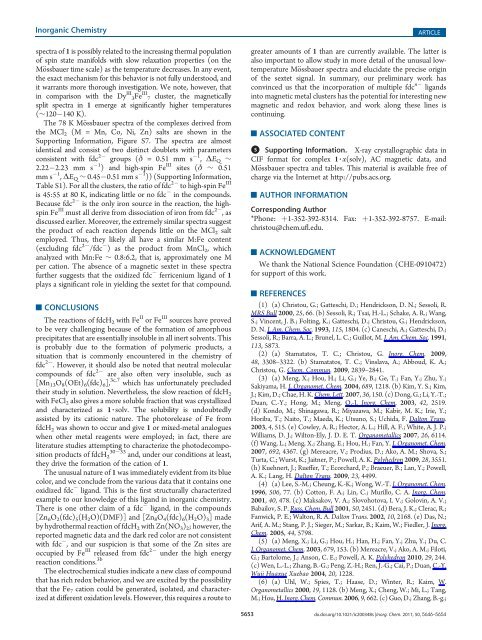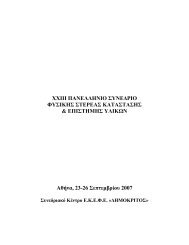Iron(III) Chemistry with Ferrocene-1,1-dicarboxylic Acid (fdcH2 ...
Iron(III) Chemistry with Ferrocene-1,1-dicarboxylic Acid (fdcH2 ...
Iron(III) Chemistry with Ferrocene-1,1-dicarboxylic Acid (fdcH2 ...
Create successful ePaper yourself
Turn your PDF publications into a flip-book with our unique Google optimized e-Paper software.
Inorganic <strong>Chemistry</strong><br />
spectra of 1 is possibly related to the increasing thermal population<br />
of spin state manifolds <strong>with</strong> slow relaxation properties (on the<br />
M€ossbauer time scale) as the temperature decreases. In any event,<br />
the exact mechanism for this behavior is not fully understood, and<br />
it warrants more thorough investigation. We note, however, that<br />
in comparison <strong>with</strong> the Dy <strong>III</strong> 3Fe <strong>III</strong> 7 cluster, the magnetically<br />
split spectra in 1 emerge at significantly higher temperatures<br />
(∼120 140 K).<br />
The 78 K M€ossbauer spectra of the complexes derived from<br />
the MCl 2 (M = Mn, Co, Ni, Zn) salts are shown in the<br />
Supporting Information, Figure S7. The spectra are almost<br />
identical and consist of two distinct doublets <strong>with</strong> parameters<br />
consistent <strong>with</strong> fdc 2 groups (δ = 0.51 mm s 1 , ΔE Q ∼<br />
2.22 2.23 mm s 1 ) and high-spin Fe <strong>III</strong> sites (δ ∼ 0.51<br />
mm s 1 , ΔE Q ∼ 0.45 0.51 mm s 1 )) (Supporting Information,<br />
Table S1). For all the clusters, the ratio of fdc 2 to high-spin Fe <strong>III</strong><br />
is 45:55 at 80 K, indicating little or no fdc in the compounds.<br />
Because fdc 2 is the only iron source in the reaction, the highspin<br />
Fe <strong>III</strong> must all derive from dissociation of iron from fdc 2 ,as<br />
discussed earlier. Moreover, the extremely similar spectra suggest<br />
the product of each reaction depends little on the MCl 2 salt<br />
employed. Thus, they likely all have a similar M:Fe content<br />
(excluding fdc 2 /fdc ) as the product from MnCl 2 , which<br />
analyzed <strong>with</strong> Mn:Fe ∼ 0.8:6.2, that is, approximately one M<br />
per cation. The absence of a magnetic sextet in these spectra<br />
further suggests that the oxidized fdc ferricenium ligand of 1<br />
plays a significant role in yielding the sextet for that compound.<br />
’ CONCLUSIONS<br />
The reactions of fdcH 2 <strong>with</strong> Fe II or Fe <strong>III</strong> sources have proved<br />
to be very challenging because of the formation of amorphous<br />
precipitates that are essentially insoluble in all inert solvents. This<br />
is probably due to the formation of polymeric products, a<br />
situation that is commonly encountered in the chemistry of<br />
fdc 2 . However, it should also be noted that neutral molecular<br />
compounds of fdc 2 are also often very insoluble, such as<br />
[Mn 13 O 8 (OEt) 6 (fdc) 6 ], 3c,7 which has unfortunately precluded<br />
their study in solution. Nevertheless, the slow reaction of fdcH 2<br />
<strong>with</strong> FeCl 2 also gives a more soluble fraction that was crystallized<br />
and characterized as 1 3 solv. The solubility is undoubtedly<br />
assisted by its cationic nature. The photorelease of Fe from<br />
fdcH 2 was shown to occur and give 1 or mixed-metal analogues<br />
when other metal reagents were employed; in fact, there are<br />
literature studies attempting to characterize the photodecomposition<br />
products of fdcH 33 2 and, under our conditions at least,<br />
30<br />
they drive the formation of the cation of 1.<br />
The unusual nature of 1 was immediately evident from its blue<br />
color, and we conclude from the various data that it contains one<br />
oxidized fdc ligand. This is the first structurally characterized<br />
example to our knowledge of this ligand in inorganic chemistry.<br />
There is one other claim of a fdc ligand, in the compounds<br />
[Zn 6 O 2 (fdc) 5 (H 2 O)(DMF)] and [Zn 8 O 4 (fdc) 6 (H 2 O) 3 ] made<br />
by hydrothermal reaction of fdcH 2 <strong>with</strong> Zn(NO 3 ) 2 ; however, the<br />
reported magnetic data and the dark red color are not consistent<br />
<strong>with</strong> fdc , and our suspicion is that some of the Zn sites are<br />
occupied by Fe <strong>III</strong> released from fdc 2 under the high energy<br />
reaction conditions. 3b<br />
The electrochemical studies indicate a new class of compound<br />
that has rich redox behavior, and we are excited by the possibility<br />
that the Fe 7 cation could be generated, isolated, and characterized<br />
at different oxidation levels. However, this requires a route to<br />
ARTICLE<br />
greater amounts of 1 than are currently available. The latter is<br />
also important to allow study in more detail of the unusual lowtemperature<br />
M€ossbauer spectra and elucidate the precise origin<br />
of the sextet signal. In summary, our preliminary work has<br />
convinced us that the incorporation of multiple fdc n ligands<br />
into magnetic metal clusters has the potential for interesting new<br />
magnetic and redox behavior, and work along these lines is<br />
continuing.<br />
’ ASSOCIATED CONTENT<br />
b S Supporting Information. X-ray crystallographic data in<br />
CIF format for complex 1 3 x(solv), AC magnetic data, and<br />
M€ossbauer spectra and tables. This material is available free of<br />
charge via the Internet at http://pubs.acs.org.<br />
’ AUTHOR INFORMATION<br />
Corresponding Author<br />
*Phone: þ1-352-392-8314. Fax: þ1-352-392-8757. E-mail:<br />
christou@chem.ufl.edu.<br />
’ ACKNOWLEDGMENT<br />
We thank the National Science Foundation (CHE-0910472)<br />
for support of this work.<br />
’ REFERENCES<br />
(1) (a) Christou, G.; Gatteschi, D.; Hendrickson, D. N.; Sessoli, R.<br />
MRS Bull 2000, 25, 66. (b) Sessoli, R.; Tsai, H.-L.; Schake, A. R.; Wang,<br />
S.; Vincent, J. B.; Folting, K.; Gatteschi, D.; Christou, G.; Hendrickson,<br />
D. N. J. Am. Chem. Soc. 1993, 115, 1804. (c) Caneschi, A.; Gatteschi, D.;<br />
Sessoli, R.; Barra, A. L.; Brunel, L. C.; Guillot, M. J. Am. Chem. Soc. 1991,<br />
113, 5873.<br />
(2) (a) Stamatatos, T. C.; Christou, G. Inorg. Chem. 2009,<br />
48, 3308–3322. (b) Stamatatos, T. C.; Vinslava, A.; Abboud, K. A.;<br />
Christou, G. Chem. Commun. 2009, 2839–2841.<br />
(3) (a) Meng, X.; Hou, H.; Li, G.; Ye, B.; Ge, T.; Fan, Y.; Zhu, Y.;<br />
Sakiyama, H. J. Organomet. Chem. 2004, 689, 1218. (b) Kim, Y. S.; Kim,<br />
J.; Kim, D.; Chae, H. K. Chem. Lett. 2007, 36, 150. (c) Dong, G.; Li, Y.-T.;<br />
Duan, C.-Y.; Hong, M.; Meng, Q.-J. Inorg. Chem. 2003, 42, 2519.<br />
(d) Kondo, M.; Shinagawa, R.; Miyazawa, M.; Kabir, M. K.; Irie, Y.;<br />
Horiba, T.; Naito, T.; Maeda, K.; Utsuno, S.; Uchida, F. Dalton Trans.<br />
2003, 4, 515. (e) Cowley, A. R.; Hector, A. L.; Hill, A. F.; White, A. J. P.;<br />
Williams, D. J.; Wilton-Ely, J. D. E. T. Organometallics 2007, 26, 6114.<br />
(f) Wang, L.; Meng, X.; Zhang, E.; Hou, H.; Fan, Y. J. Organomet. Chem.<br />
2007, 692, 4367. (g) Mereacre, V.; Prodius, D.; Ako, A. M.; Shova, S.;<br />
Turta, C.; Wurst, K.; Jaitner, P.; Powell, A. K. Polyhedron 2009, 28, 3551.<br />
(h) Kuehnert, J.; Rueffer, T.; Ecorchard, P.; Braeuer, B.; Lan, Y.; Powell,<br />
A. K.; Lang, H. Dalton Trans. 2009, 23, 4499.<br />
(4) (a) Lee, S.-M.; Cheung, K.-K.; Wong, W.-T. J. Organomet. Chem.<br />
1996, 506, 77. (b) Cotton, F. A.; Lin, C.; Murillo, C. A. Inorg. Chem.<br />
2001, 40, 478. (c) Maksakov, V. A.; Slovohotova, I. V.; Golovin, A. V.;<br />
Babailov, S. P. Russ. Chem. Bull 2001, 50, 2451. (d) Bera, J. K.; Clerac, R.;<br />
Fanwick, P. E.; Walton, R. A. Dalton Trans. 2002, 10, 2168. (e) Das, N.;<br />
Arif, A. M.; Stang, P. J.; Sieger, M.; Sarkar, B.; Kaim, W.; Fiedler, J. Inorg.<br />
Chem. 2005, 44, 5798.<br />
(5) (a) Meng, X.; Li, G.; Hou, H.; Han, H.; Fan, Y.; Zhu, Y.; Du, C.<br />
J. Organomet. Chem. 2003, 679, 153. (b) Mereacre, V.; Ako, A. M.; Filoti,<br />
G.; Bartolome, J.; Anson, C. E.; Powell, A. K. Polyhedron 2010, 29, 244.<br />
(c) Wen, L.-L.; Zhang, B.-G.; Peng, Z.-H.; Ren, J.-G.; Cai, P.; Duan, C.-Y.<br />
Wuji Huaxue Xuebao 2004, 20, 1228.<br />
(6) (a) Uhl, W.; Spies, T.; Haase, D.; Winter, R.; Kaim, W.<br />
Organometallics 2000, 19, 1128. (b) Meng, X.; Cheng, W.; Mi, L.; Tang,<br />
M.; Hou, H. Inorg. Chem. Commun. 2006, 9,662.(c)Guo,D.;Zhang,B.-g.;<br />
5653 dx.doi.org/10.1021/ic200348s |Inorg. Chem. 2011, 50, 5646–5654
















